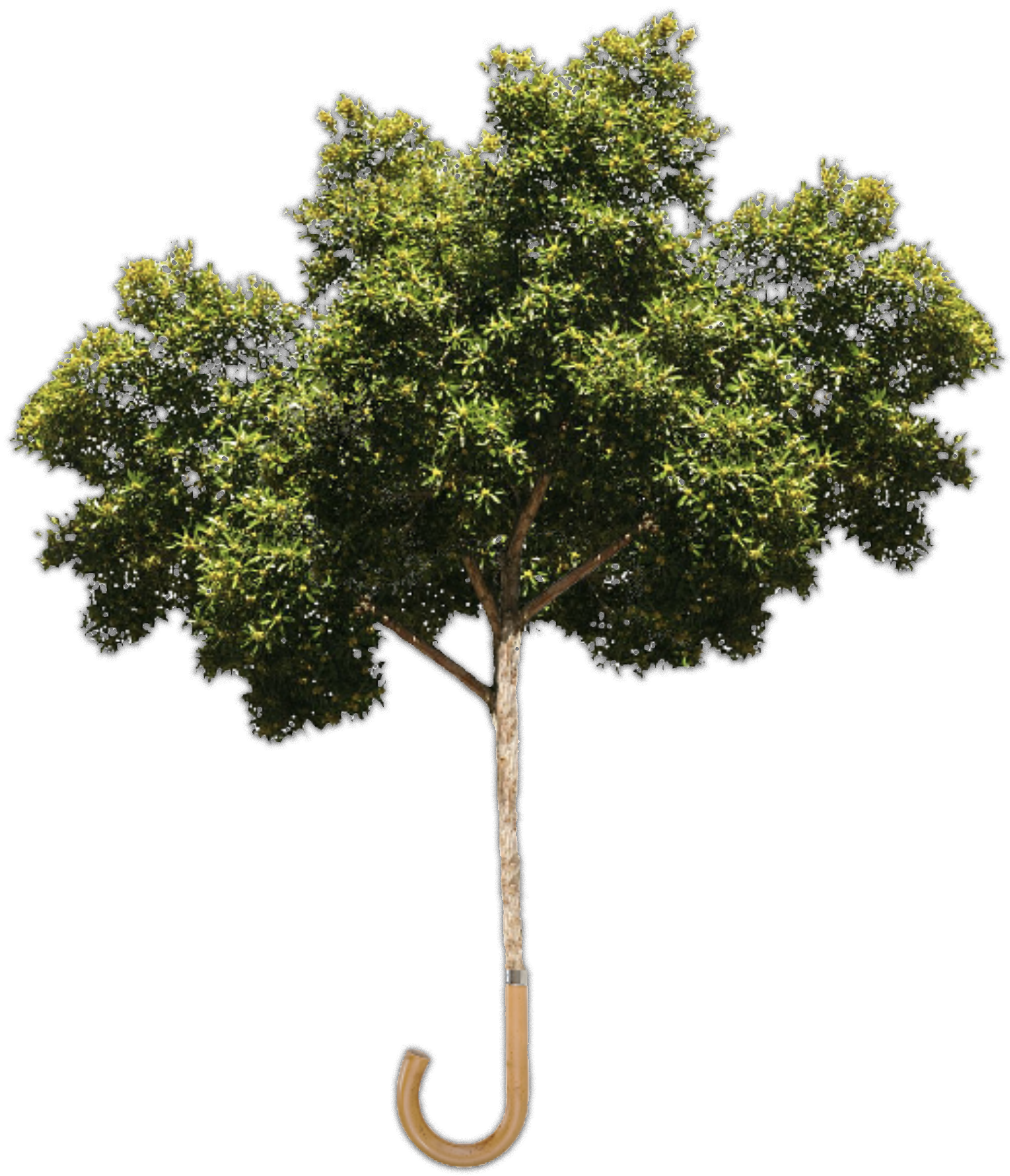
Shade in the City
Rising Heat Inequity in a Sunburnt Era
We have an open call for new poetry on the concept of shade equity.
In a warming world, shade equity is an issue that disproportionately affects low-income and working-class communities, people of color, and communities in developing nations who are more likely to work outdoors, rely on public transportation, and live in denser neighborhoods with a lack of trees and shade. As the climate changes and heat waves become longer, more intense, and more frequent, what was once thought primarily as an aesthetic amenity is increasingly recognized as a way of protecting the public health and well-being of marginalized communities. Urban heat causes more deaths than all other weather-related causes combined in an average year, and yet providing shade can be simple and effective and can be done in many creative ways including tree planting, bus stop sheds, and awnings, to name a few.
Shade in LA
To tackle the issue of urban heat, a group of 18 artists and activists in Los Angeles’ vibrant Highland Park neighborhood raised awareness of shade as an equity issue in an outdoor public art installation called Shade in LA | Rising Heat Inequity In A Sunburnt City. Organized by community-based arts organization Arroyo Arts Collective, the project invited emerging and established artists to use repurposed umbrellas as their canvas to explore the themes of shade, heat, nature, and climate change. Shade in LA was installed outside of the Avenue 50 Studio space in the spring of 2022, with each umbrella suspended high above visitors. The installation served two audiences: train passengers who got a glance of a colorful and visually impactful installation; and visitors and pedestrians who interacted with the umbrellas by walking or sitting under the installation.
A Virtual Exhibit of Shade
The 21 umbrellas from 18 artists in the original exhibit are reproduced here, for you to explore along with the artist statements. To these we invited 14 additional observers to “meditate” on the umbrellas or what the idea of “shade” brought to mind for them. As is our method here at TNOC, these 14 meditators are from diverse ways of knowing, including climate scientists, physicians, poets, and urban planners. They use the ideas expressed in the umbrellas as a starting point for reflections from the perspective of their own practice.
Explore the Umbrellas
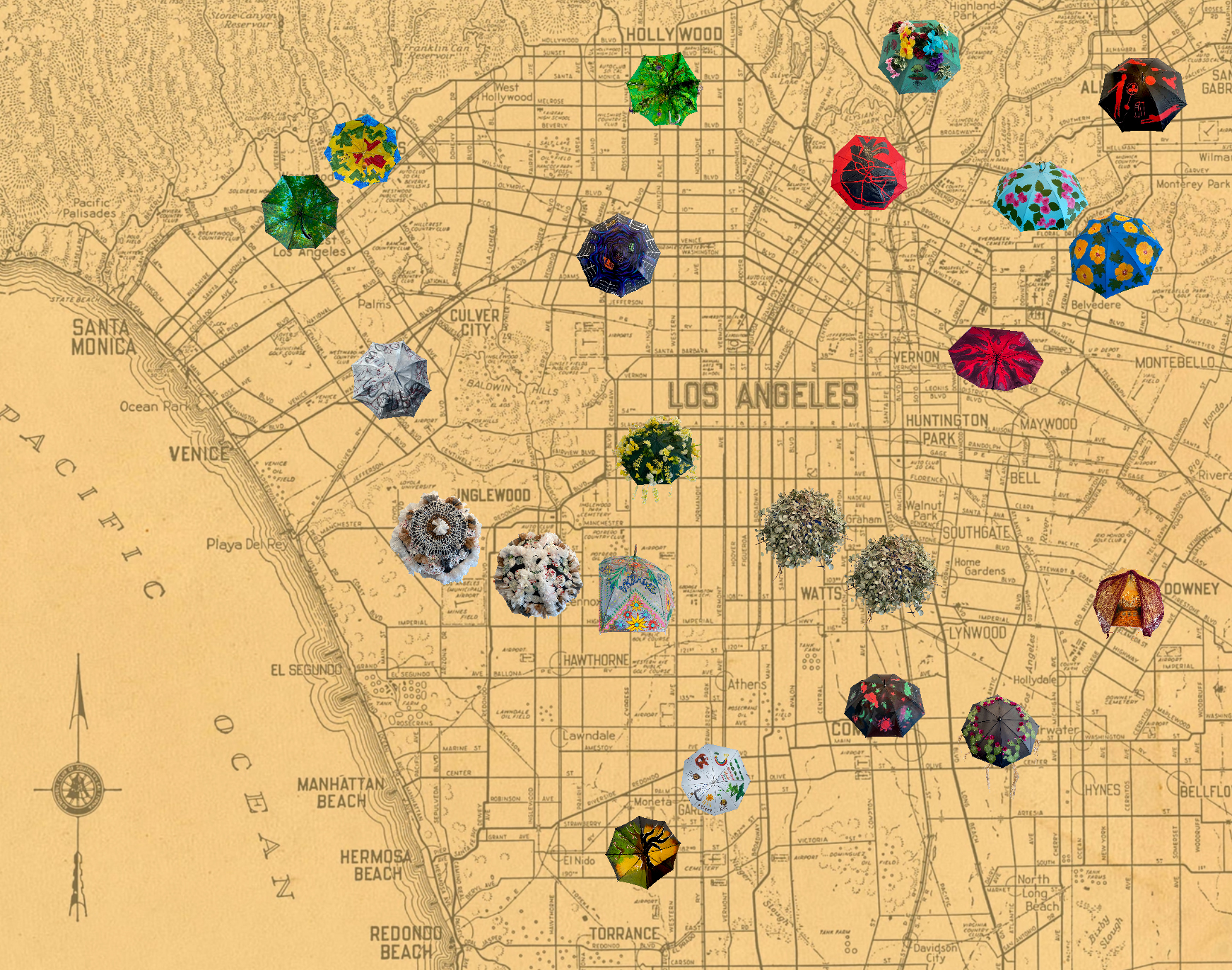





















Redlined, No Shade
Chantée Benefield
chanteeb.com | IG: @artistchantyb
This is a slightly abstracted version of maps created in the 1930s that encouraged segregation and denied investment in certain neighborhoods.
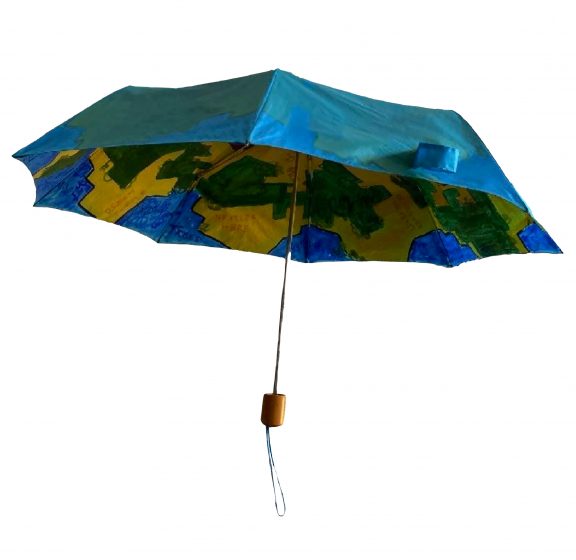
I’m completely captivated by Benefield’s ‘Redlined, No Shade’ umbrella. While it speaks directly to one of the major reasons we see shade inequity in US cities, it also contains an accurate representation about how these areas were geographically distributed with the center of the umbrella representing the center of an urban area, and progressively moving to green and blue colors towards the edges. The colors are remarkably close to the actual colors of these maps, and they provoke a series of questions for me, including: How might a museum in the 1950s have responded to this umbrella and the message it is sending about the inequities that current policies are generating? How might shade reflect the differences in color that we see on the maps and on people’s faces — red as hot and blue as cool?
Vivek Shandas, PhD
Professor of Urban Studies and Planning, Portland State University
Cool Canopy
Chantée Benefield
chanteeb.com | IG: @artistchantyb
The piece recreates the feeling of being in nature, underneath a canopy of leafy trees, enjoying the vibrancy of green, cool shade.
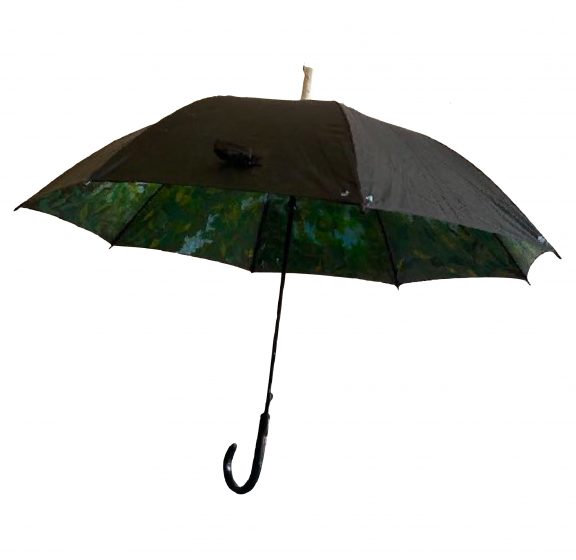
The ‘Cool Canopy’ umbrella really does evoke the wonderful feeling of standing under a dense canopy of trees. For me, it suggests more than just shade, although I recognize that shade can provide a significant cooling benefit. It made me reflect on the multiple benefits that these trees may provide, often referred to as ecosystem services, including improved air and water quality, wildlife habitat, and recreation. The image on the umbrella also feels soothing to me, which makes me think of the notion of biophilia, and decades of research in environmental psychology, both of which suggest that we as humans have an innate need to connect with nature. These are all reasons why I believe it is problematic that some neighborhoods have a lot less tree canopy […] If we want to make our cities resilient to increasing heat risks, we need to acknowledge and address these inequities. Indeed, many U.S. cities are expanding urban forestry programs to address heat. Reducing disparities in tree canopy cover can be part of the long-term solution, but there are many other strategies cities should also implement to both mitigate heat and manage its consequences.
Sara Meerow, PhD
Professor of Planning, Arizona State University
Trapped in the Oil Cobweb
Joe Bravo
joebravo.art
As we use up more fossil fuels such as oil and coal, the pollutants released into the atmosphere by our machines further destabilize our climate, causing the wildfires, extreme heat, and other environmental disasters we are now experiencing. The public is caught in a spider’s cobweb of oil consumption that covers the world. We can throw some shade on our climate dilemma by conserving our natural resources and developing reusable energy alternatives sooner rather than later.
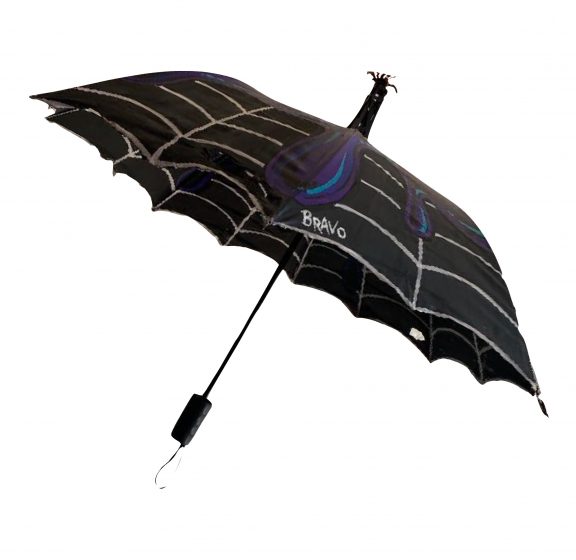
Prickly Pear in Bloom
Mary Cheung
notjusttheordinary.wixsite.com/marycheungartist
IG: @notjusttheordinary | FB: @marycheungartist
This is a story about endurance and resilience and survival. I’d like to also think that the Prickly pear is also a metaphor for us as human beings. If we have strong roots than we can endure even the harshest of times, and whether through the good or bad, to come out blooming and flourishing. The parallels and similarities are there. Through devastation and destruction of mother earth, we can come back from it all if we take care and have the patience to stay the path and nurture the earth again so that we might one day bloom.
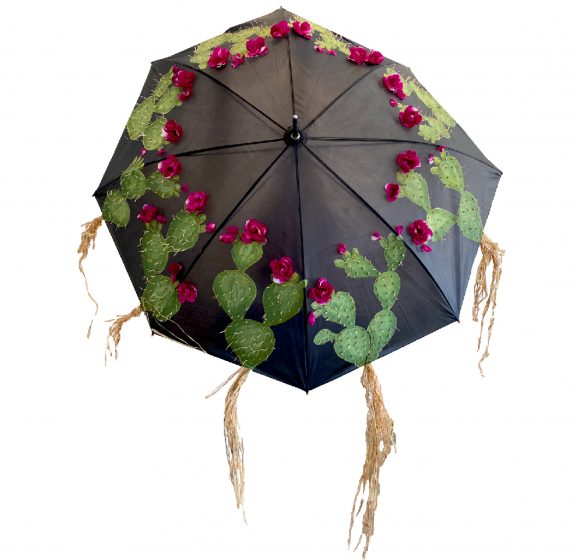
The ‘Prickly Pear in Bloom’ umbrella really spoke to me. I loved the colors, I loved the representation of the native flora – the beauty and resilience that is in there. It’s a reminder that some of arid environments don’t have lush trees, but that the flora that they do have is still beautiful, functional, precious, and valuable.
Umbrellas and shade from umbrellas are actually something that has specific connotations in the part of the world that I live in, in cities like Dubai and Abu Dhabi in the UAE (United Arab Emirates) where the climate is very hot most of the year. There’s a specific group of people, usually the female service workers, who carry umbrellas because they can’t afford transport by private car, so they use public transport and often the last mile isn’t shaded. So the umbrella is a practical and cost effective way of being comfortable in the outdoors.
And I’ve started to do the same; carry around an umbrella in my car with me and it’s come in really handy, because really all it takes to go from unpleasant to acceptable, or even pleasant, sometimes is shade and there are some cost effective and water-efficient ways of providing shade for everybody.
Huda Shaka
Planner, Dubai
Umbrella for the People of Ukraine
Aleka Corwin
alekacorwin.com | IG: @alekacorwin
This one is my interpretations of Ukrainian folk art, a glimpse of color and happiness for the Ukrainian people, and also for the beleaguered Earth in the face of ravages from climate change and war.
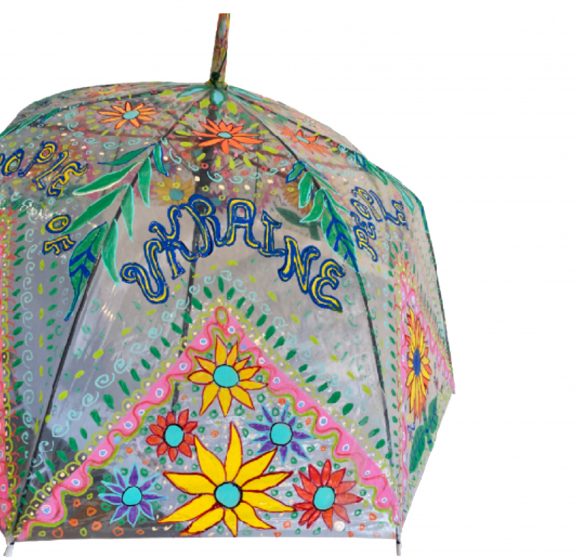
Umbrellas have never been only about function. Umbrellas have a long history of dual purpose that dates back at least two thousand years in China, where they offered protection and were symbols of status. The earliest Chinese umbrellas were constructed of either silk or paper, with elaborately painted scenes of landscapes and animals. Used by nobles, aristocrats and the wealthy, umbrellas were symbols of prestige and power. Their status was enshrined by the first emperor of China, Qin Shi Huang, who had buried with him more than 8,000 terracotta soldiers, among which was a large umbrella shading a chariot and charioteer. Eventually, umbrellas became an accessory for the elite and fashionable women around the world.
The exhibit, “Shade,” reflects how much the users and status of umbrellas have changed over the past several millennia. Today, across East Asian cities, from Shanghai to Singapore, Tokyo to Taipei, it is common to see pedestrians use umbrellas as protection from the sun and rain. In East Asia, pedestrians are ubiquitous, because cities are designed around humans and public transportation is convenient. In East Asia, even people with financial means to own private vehicles use public transportation. Hence, nearly everyone needs an umbrella because nearly everyone is a pedestrian. In East Asia, umbrellas are no longer symbols of power; they serve utilitarian functions. In L.A., pedestrians are rare, because the city is designed around the automobile and public transport is inconvenient. In L.A., pedestrians are more likely to be those who do not have the financial means to own private vehicles and thus are more exposed to rain and sun. In L.A., umbrellas are not symbols of power and prestige; they serve utilitarian functions for the exposed. Those who bear the brunt of heat need umbrellas. More than ever, umbrellas are not only about function. They offer protection and also symbols of exposure.
Karen C. Seto
Faculty Director, Hixon Center for Urban Ecology and Frederick C. Hixon Professor of Geography & Urbanization Science
Rainforest
Aleka Corwin
alekacorwin.com | IG: @alekacorwin
I wanted to create a restful and lush fantasy environment of cool dense growth.
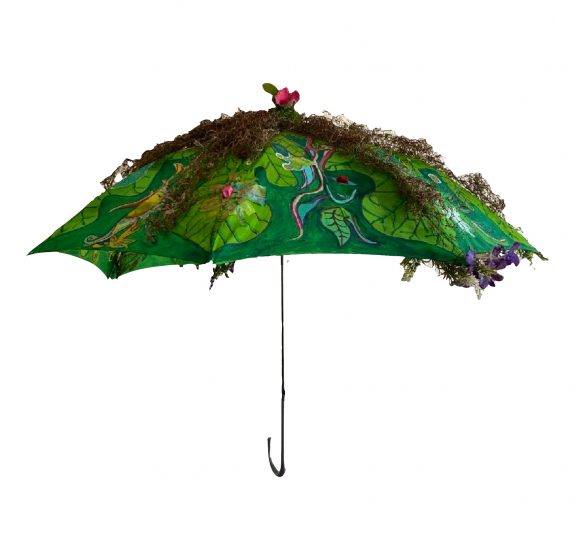
Such
Heart
Aspires to
Delicate
Oasis,
Wonderfully.
Emilio Fantin
Artist, Bologna
Hanging Garden #1 and #2
Pascaline Doucin-Dahlke
pascalinedoucindahlke.com
Even though we love the famous California sunshine with its constant warm temperatures, blue sky, and bright light, we realize that this lifestyle comes with a cost in a world with climate change. It brings drought, devastating fires, extreme heat and associated health issues. When the sun bakes our Los Angeles neighborhoods, we are all looking for shade to cool off and to prevent us from health issues (heat stroke, dehydration, skin cancer, etc.).
Since we are lacking trees as natural shade structures in many parts of the Los Angeles area, especially in working-class neighborhoods, I created a ‘Hanging Garden’ with a recycled plant material treatment on top and below two umbrellas to demonstrate that nature and our collective creativity offers solutions to climate change.
I found interesting plant droppings on the street in my Los Angeles neighborhood (seed pods and leaves) and harnessed eucalyptus branches from a neighbor’s tree. I have tested the eucalyptus leaves and seed pods on other projects so I know they will have long durability sufficient for the duration of this project. To increase the shade area, I am adding a bamboo structure below the umbrella that extends past the umbrella perimeter. A rope artistically weaves between the bamboo to provide shade and connect the bamboo structure to the umbrella.
The umbrella cover is painted in two colors (orange below and red / orange below and blue). I added a dried orange to show trees can also produce fruits in addition to shade and flowers.
The installation aims at people to bring their mobile chair and to capture the shade in different locations. It creates a flexible protected space and will engage social contact.
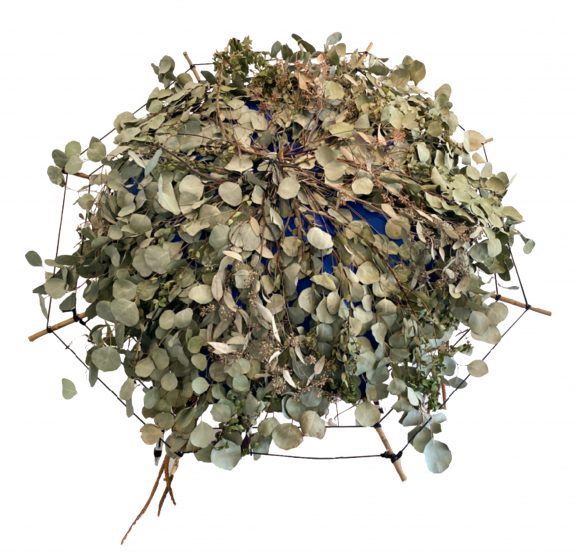
Cities like LA, Hyderabad and Milan are increasingly becoming Very Hot Cities, for some or all parts of the year, making them unlivable. But what does ‘unlivable’ mean for those who are forced to stay in a city during a heat wave because they have nowhere else to go? Which is, of course, the state in which most of the city’s population usually finds themselves.
It is the most vulnerable – the street vendors, homeless people, beggars, traffic police, construction workers, road cleaners – who have to deal with the worst of the heat. As we pour more concrete into cities, making heat waves intensify, the Right to the City is increasingly becoming all about having or not having the Right to Shade. And yet, shade is one of the least studied, discussed or taught topics in areas such as landscape design, urban ecology, city planning or architecture, fields of enquiry that have a major influence on the shape and form and life in built cities.
As one street vendor, a young man in Hyderabad, told Sukanya Basu – shade is useful because it attracts more clients, who come to chat and spend time under a tree, and then end up buying some food, or a glass of sugarcane juice, adding to his income. Another woman, also a street vendor, only had access to a small tree, whose a canopy that provided little shade – but she tied a piece of plastic to the tree trunk, anchoring it to create a little shelter for herself, while she enjoyed the occasional breeze blowing through its branches.
The word for shade in my language, Kannada, is ನೆರಳು (Neralu) – a word associated with many meanings, as words often are – with ideas of shelter, safety, wellbeing. A local, community-run tree festival that ran in Bangalore for some years was called Neralu, for the same reason. The day our cities lose their Neralu, they turn inhospitable, barren, unsafe.
We all need the Right to Shade.
Harini Nagendra
Ecologist and Novelist at API, Bangalore
I Heart L.A.
dearantler
dearantler.com | IG: @dearantler
Look closely — what do the lines mean? Within the shape of a human heart, lines reveal a map of LA’s freeways — geographic features that orient most Angelenos and split neighborhoods and communities.
Urban planning choices and the wellbeing of LA communities are inextricably linked, and there is no untethering of LA’s arteries — its streets, creeks, freeways, storm channels — from our own coronary arteries, and more broadly, to public health. We experienced this connection in high relief on September 6, 2020. On that day, LA experienced its highest recorded temperature of 121ºF — a temperature that would have been unimaginable without human-induced changes to the climate, including greenhouse gas emissions and the preponderance of heat-retaining built environment surfaces that surrounds us.
The clever juxtaposition of a beating heart against Los Angeles’s asphalt roadway “arteries” highlights for me the love-hate relationship that a city can have with freeways and the sprawling urban growth those roads have nurtured. On the one hand, freeways can link us. Like blood capillaries in our body, cars flow across the city; a continual pulse of movement that, on the surface, seems to connect us with people, places, and things. On the other hand, history shows that our freeway’s legacy also divides us. By bisecting communities, roads often break the heart and minds of a neighborhood. For example, one’s well-being and health are often tied to which side of the freeway you live.
The backdrop of blood red in this piece emphasizes for me that there is a noticeable absence of nature in these broken neighborhoods. An absence that is keenly felt by all as temperatures skyrocket, exacerbated by a changing change and the heat-absorbing black asphalt. Is our heart in the right place?
I personally believe that this hardened heart does not reflect the spirit and ideals of Angelinos. This umbrella piece also invites us to open our hearts and minds to what we really value as an individual, community, city and region. Los Angeles will always be synonymous with freeway culture, but maybe we should be following our hearts in a new, greener, and equitable direction.
Miranda Hutten
Natural Resources Manager, USFS, Los Angeles
Clusters of Reality 2D
Angela Hernandez
IG: @smokeyz.art
My piece outlines a variety of present day issues with our climate, such as rising temperatures, our ice lands slowly melting. My art also addresses the before and after effects of climate change. I am advocating for this land we have been given. It is necessary for our community to be aware of its effects.
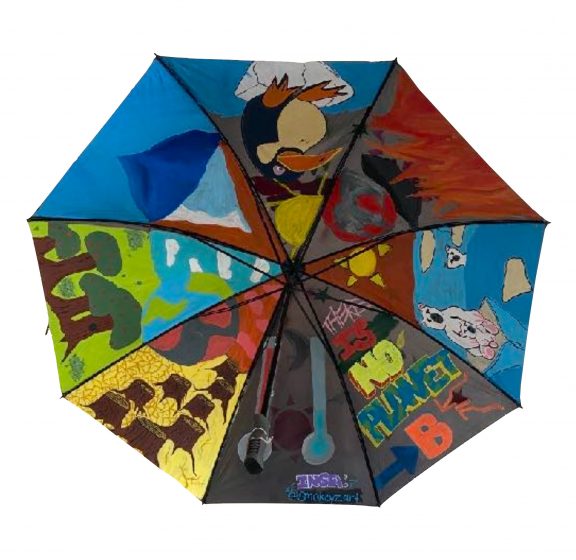
To think about shade is to think about the sun and its connection to life and death on earth. Each of the 23 umbrellas in Shade in LA finds a place on this spectrum to articulate a statement. Most of the works, like Where’s Shade, Rainforest, and Cool Canopy celebrate the connection between sunlight and plant life. Others, like Trapped in the Oil Cobweb, Wildfire Smoke, and California’s Wildfires and Deer, underscore the disasters connected to relentless sun and climate change.
Sometimes the best seat is in the shade; sometimes it is in the sun. Shade is more tangible in urban environments. Occasionally, it is even litigated. When a tower is proposed for a plot of land near a garden it does not “create shade” it “casts a shadow.” The future shadow of a forthcoming luxury tower is as real as it is unwelcomed for it will steal a portion of the sky that feeds so many plants.
Meanwhile, yesterday I spent $300 on shade for plants. Now we anxiously await rolls of shade fabric so we can install them above a little farm growing on the rooftop of a school in the South Bronx. All summer long we have kept this new garden well watered, but it wasn’t enough. The direct sun and resulting heat is too much for the plants to handle. Instead of growing lush and fruiting they are stunted in a fight to survive. On a sunny summer day the rooftop reaches 110 degrees and the scorched air moving across the asphalt roof and down the redbrick walls is too much for the plants to handle. But that will change soon, on Thursday or Friday or Monday, when the shade finally arrives in the mail.
Matthew López-Jensen
Artist and Photographer, New York
Shade in LA
Diana Kohne
dianakohne.com | IG: @dianakohne
Under the shade of the umbrella, the viewer is invited to contemplate how the comforts of privilege contribute to the real life tragedies and discomfort of the unshaded, whose experiences are depicted on the top of the umbrella.
The more privileged a person is, the more they consume. It is consumption that creates carbon emissions. Carbon emissions are a greenhouse gas that cause warming and climate change. The more people consume, the more they harm low-income communities. To bring attention to this, I utilize illustration and the two sides of the umbrella as a metaphor for the disparate experiences and contributions to climate change by the privileged and the non-privileged.
On the underside of the umbrella, protected by shade, I depict things privileged people consume that create the carbon emissions that contribute to global warming. The practices of the people who have the protection of privilege are causing things to heat up faster, and the people who aren’t “shaded” by privilege are the most impacted. In some cases, the things that contribute to warming are also used to avoid its impact.
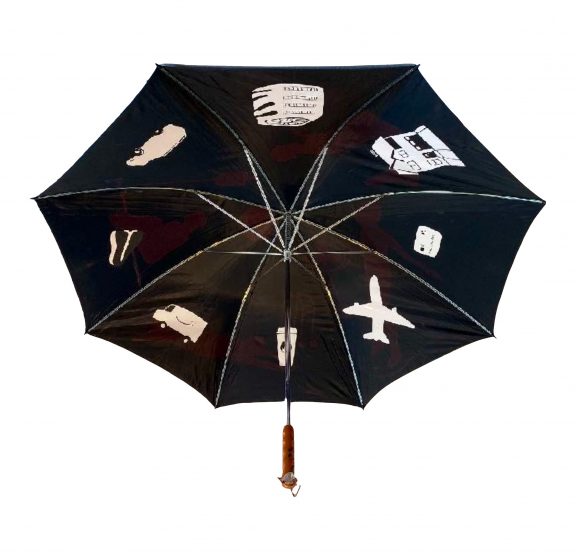
Sun and Shade
I am walking down the street in the shade
Of a building a block long
One third of the street is cradling me with ease
Two thirds in dense sunlight, where I cannot walk.
The sun feels murderous, like a weapon,
102, 105 degrees today and no one should be out.
Yet I choose to go to the museum
Which offers beauty, comfort, and A.C.
I am one of the fortunate people
Because I have enough money, a car, a choice.
When I return home, it will be cool
With thick walls, fans, and trees.
But what if I couldn’t surround myself in comfort?
What if, like my grandmother in the Bronx,
I had a hotbox apartment with one fan and rooms
Which held the heat close?
As a little girl I helped drag mattresses
Up to the roof a six-story brick building,
Hoping we could catch a cool breeze or at least
Pretend that the New York night was cooler than the day.
What if I was a migrant worker, picking oranges, grapes, or lettuce
Under a straw hat, with sweat pouring down my face,
Exhausted from the work and heat of California days
With no cool respite, no succor, no recourse?
What if I was waiting for the bus to go home,
Standing in the harsh late-afternoon sun with others,
After a day of cleaning the beautiful houses
Filled with delights and comforts we could never buy?
What if I was that FedEx delivery man I saw on the news:
driving around L.A. delivering packages all day,
in the searing heat under merciless rays who
finally collapsed on the grass under a Palm Tree?
Or the children who wanted to play at recess
But had to stay imprisoned inside the school
(with faulty air-conditioning) because it was
Too hot and dangerous to play in the school yard?
What if I was one of those folks who lived in a house
That had to be evacuated because of a wildfire,
and I had to stuff my kids and my pets, my photo albums and
computer, whatever I could grab, into the car and get out fast?
What if I was: an almond farmer, a firefighter, a homeless lady and her cat?
Where is her comfort, where is her shade?
Thankfully, I turn on my car radio and the AC, head home for a cool shower.
Waiting for the orange L.A. sunset, and the temperature to drop.
Aleka Corwin
Artist and Poet, New York
Wildfire Smoke
Yvette Nicole Kolodji
IG: @ynk_arts | FB: YNK ARTS | Twitter: @ynk_arts
With climate change, Los Angeles has experienced more poor air quality days from wildfire smoke. These increased fires are emulated with red flames radiating from the center towards the edge of the umbrella. Curved plastic bottles sway in the wind to creates swirls of smoke. Plastic bottles symbolize the lack of water and the umbrella references the lack of rain. The plastic bottles draw attention to the bottling industry in California removing millions of gallons of ground water. Ultimately, this amplifies the dry conditions leading to these wildfires. As an observer below the umbrella, the smoke is closest to the viewer. Although wildfires create immense amount of damage, the smoke travels miles and miles beyond and can also cause harm.
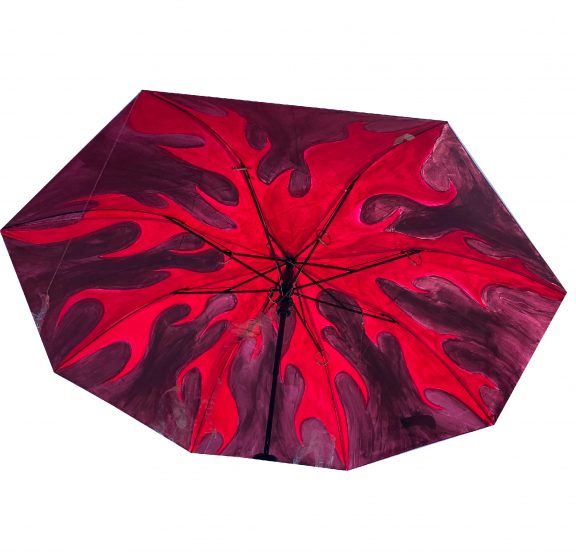
Where’s Shade
Marco Nochebuena Luna
IG: @nochebuenaluna
My work addresses issues of shade and themes such as wildfire, climate change, and heat, as well as how we as humanity should stop murdering our mother earth and instead heal everything. Nature always wears the colors of the rainbow, shade is important and something we should all have rather than suffer from.
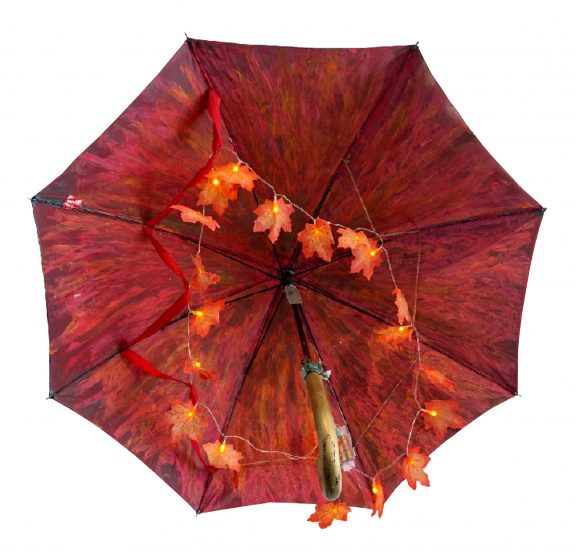
The Remains
Gabriel Macias
IG: @benetts_art
My piece is about how wildfires and heat can permanently damage the environment. It shows how wildfire is dangerous, leaving only burnt remains. It’s also about Yin and Yang, the balance of life, and how everything we consider bad / ugly also has a good / beautiful side to it.
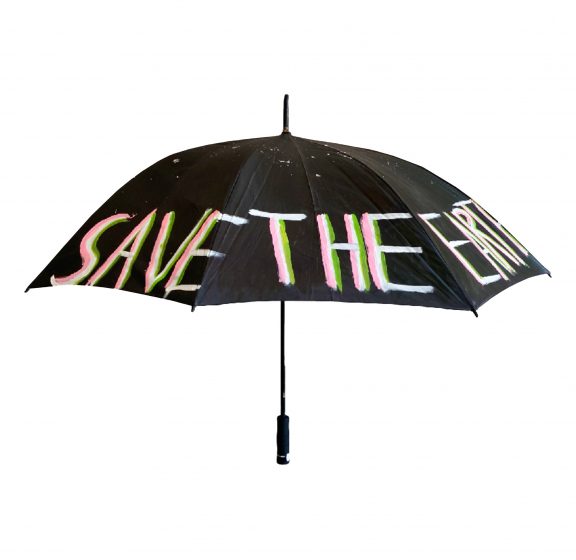
Many of the artists depicted plant life—trees, rainforest, bougainvillea—in their work. I think the juxtaposition of natural themes on an unnatural medium helps draw our attention to the many ways we can achieve shade, and the way all of those features work together as ‘shade infrastructure’ to reduce the heat burden that sunlight puts on the human body.
Kelly Turner, PhD
Professor of Planning and Center Co-Director, UCLA Luskin Center for Innovation
Clear As Day
Brianna Mitjans
IG: @briannamitjans
My piece is a nod to Larry Itliong, a Filipino Community leader who led the farm worker movement on the West Coast. His efforts started the movement and joined forces with Cesar Chavez to fight for the rights of agricultural workers. My piece promotes visibility of immigrant agricultural workers’ unseen sacrifices to feed America and support their families. Shade, heat, and climate change are huge factors into who works in fields and how they can make a living. Shade equity not only comes in the form of shielding from the sun but the inequality of shades of skin who work in harsh weather conditions.
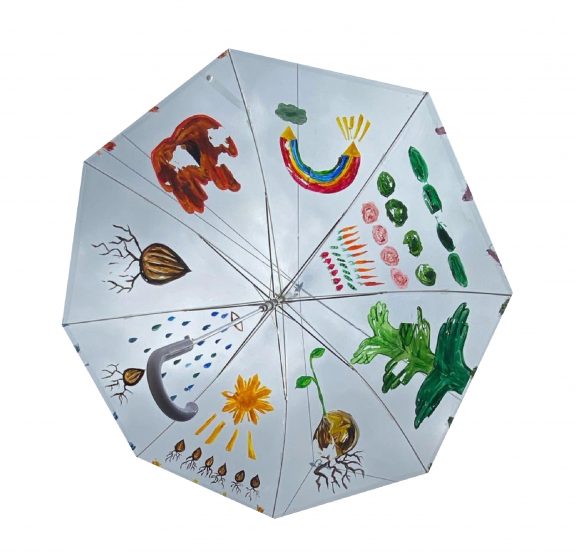
More Umbrellas, Please
Found a sprouting tree seed.
A real treasure in a very cool find.
Didn’t know its nature, nor its source
or if it would produce enough to feed
the homeless, and those in a bind.
I loved it, nurtured it, of course.
For years it drank the water I shared
and sprouted both days and nights
birthing long limbs and leaves for shade.
It craved water from hands that cared
and grew to very broad shady heights.
I named it: Drought’s Bridesmaid.
Rain stopped. Years ago. Hot sky flared,
defying our need for cooler days and nights.
Even so, folks wasted water, killed the shade.
Everything’s OK the politicians declared.
So tourists came for celebs, prehistoric sights
finding LA hot, brittle, in need of first aid.
Cities and suburbia held a canopy of heat.
Science warned us, the masses disinclined.
My survival needed action, not remorse.
Dead trees sprouted umbrellas above concrete –
my small plan for cooling, and shade redefined.
I bought more umbrellas, of course.
Constance Patrick
Poet, Arizona
California’s Wildfires and Deer
Rebecca Nabarrete
sensoryoverflow.com
My piece draws attention to the trauma wildfires can cause wild animals, with the dramatic scene of two deer seeking refuge in the water. The umbrella is reminiscent of a jellyfish, which references how much climate change encompasses every habitat on earth.
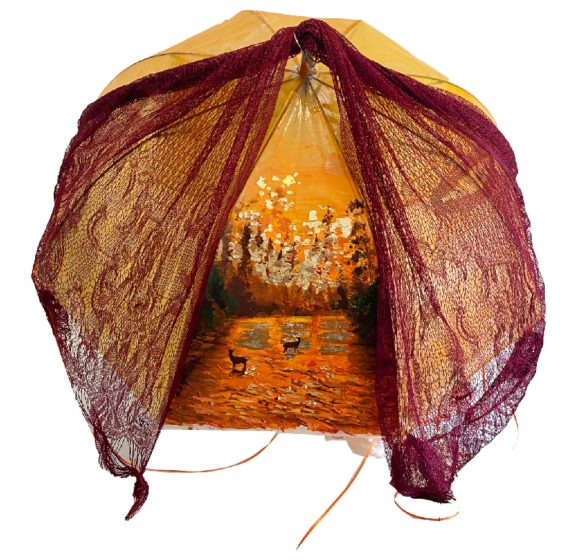
I think we don’t talk enough about the dual nature of wildfires. Terrifying, destructive, traumatic of course. But they are strangely beautiful too as seen in this umbrella. We know they can help the land regenerate, so beauty is inherent; it is not just an aesthetic description. I own a paper collage from Francesca Gabbiani of a wildfire. I bought it two decades ago when I first moved to California. At the time, wildfires were not the climate change indicator they are now and I bought it for the beauty. I still have it hanging in my bedroom.
David Eisenman, MD, MSHS
Physician and Professor, UCLA Schools of Medicine and Public Health
I’M ON FIRE !!!
Isabel Olvera
IG: @M.onkeydraws
My piece shows a tree on fire, the stem of the umbrella being the bark, and the wood chipping being the fire. It is also about trees that are being cut down just to make more land for development. On top of the umbrella is a moon / moon wobble that also is a factor with climate change.
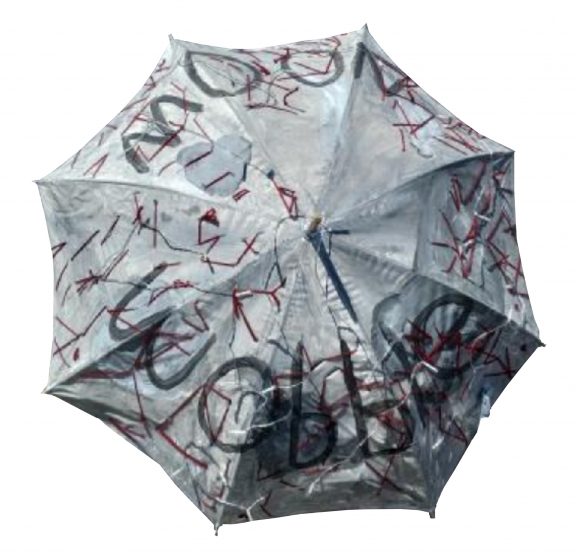
“To sit in the shade on a fine day and look upon verdure is the most perfect refreshment.”
– Jane Austen
Never like this year have I felt the power of a sliver of shade. I am almost sixty but I never remember such a hot spell, with the temperature rising to almost 40 C already at the end of May… Relentless sun, day, after day, after day and no rain in sight. Our well dried out and in the end we decided to give up on the vegetable garden, it just was not worth it. The only respite is under the big oak tree that sits in front of the house, regaling us with a cool spot under it glorious canopy.
In the city of Rome, people zigzagged across the streets trying to find the cooler path to their destination, skipping from one tree to next and getting away from the boiling asphalt. I traveled to Germany and then to Belgium seeking cooler climates… 38 degrees in Frankfurt, 35 in Bruxelles. After a summer like this, I am simply exhausted. I guess we are just not built for this…
Was this a blip? A freak season? Most probably not. How will we make it through the next one? We need to build resilience. And what better teacher of resilience than Nature? We need to learn from Nature how to build a shield, an umbrella to protect us from the sun. To create gardens around us and gardens above us, in our streets and squares but also on our balconies and roofs, hanging gardens to help us all get through the next heatwave, and the one after that… And who knows, maybe one tree, one shrub, one plant, one hanging garden at a time, we might get our cities back, our vegetable gardens back and our wells will be full again.
Simone Borelli
Urban Forestry Officer, Forestry Division, FAO, Rome
Plastic Umbrella #1 and #2
Cat Chiu Phillips
catchiuphillips.com | IG: @catchiuphillips
Plastic Umbrella is made out of plastic waste. Even though a single-use plastic bag ban has been adopted in Los Angeles County, there is still an exorbitant amount of plastic around. We continue to struggle to reduce the harmful and negative environmental and economic impacts associated with plastic.
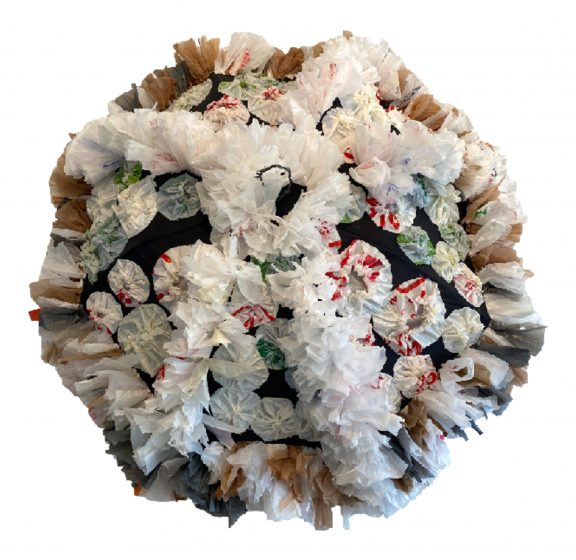
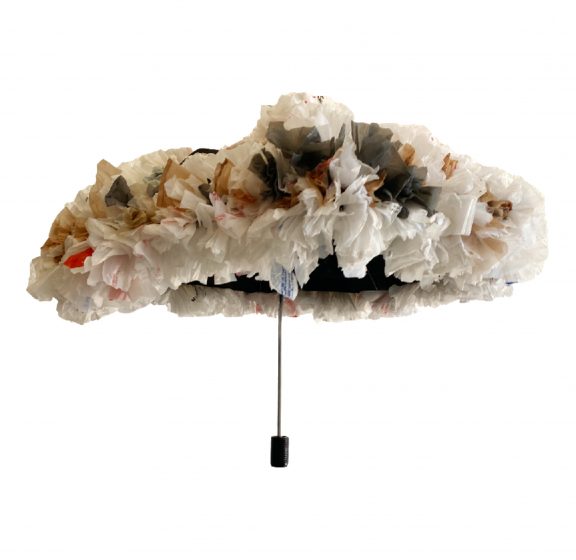
Shade. I truly enjoy how shade creates small safety bubbles where you can stop and recharge your energy during extremely hot days. In recent years my Nordic Latvia is turning into Mediterranean Latvia. Now in summertime I plan my way through the streets looking for shadow oasis – trees – trying not to overheat.
Do you know who else likes to spend time in shadow during summer? Fish and all small creatures in the river. You may ask why? Small insight from the underwater world – oxygen dissolves better in colder water than in warmer one. It is very important that some parts of the river are hidden in shadows because then the water doesn’t heat up so extremely and there is a higher chance that this water will contain more oxygen. So, you can say that water creatures also like to stop in the shade and take a rest because they also need oxygen to survive as we – humans – do.
Marta Dievina
Aquatic Biologist, Latvia
It’s my turn!
Adriana Strothers
IG: @adriana.s.art
Through the Arroyo Arts Collective and Rock Rose Gallery, I was able to gain the opportunity to create this piece using a recycled umbrella. The piece signifies “shade equity” in the sense that not only humans fight for shade underneath resources like trees, but animals do as well. This is shown through the squirrel reaching for the shade from the umbrella that is the tree, and the chameleon climbing up for more shade.
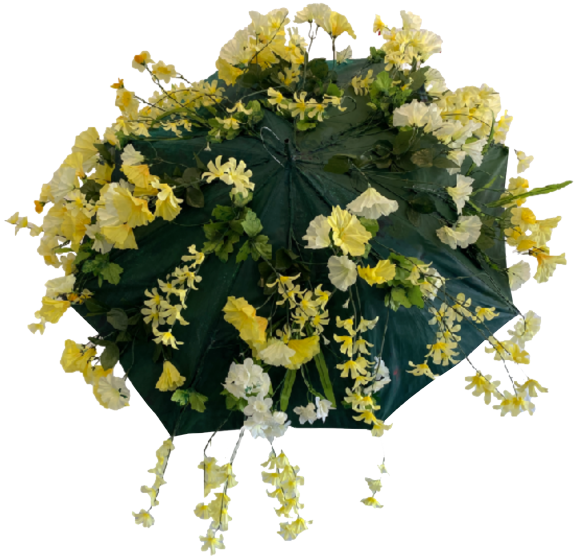
high rise
when the heat hits LA and the concrete slab of the city stabs hardened soles of feet whose will they be not the ones sporting horsebit-detailed loafers twenty-six floors above ground level grassroots blue collar laborers steadying their aching bones on scaffolding surrounding new sky rise building waving to washers of windows precariously tethered to the erection next door no it will be the ones heavy weight lifting sweating in swim steel toe boots callous handed down from uncles too big but they’ll grow in to them with time assume the role of the overlooked underpaid scapegoated often deported shorted distorted contorted into funhouse mirror imaginations from windex streaked high rise view can’t help it can’t help but step over unhomed bodies sleeping in office building thresholds can’t help it can’t help but turn away though your pockets are fat as your overfed belly hungry ghosts wandering pondering nothing of consequence i don’t mean to throw shade or stones from my little glass studio but when so many making your life so comfortable come to the one room apartment they call home to their family of six do you not think there might be something amiss or do you just kiss your wives on their rigid lips as you fob the mercedes and narrow your gaze as you make your way between ever expanding encampments damn it there i go again can’t help it can’t help it can’t help i want to write from a higher plane but my re collection only seems to want to gather the fruits that have already fallen to the blistering ground round up our loves and losses and toss them into the great compost heap of mistakes we make when we can’t yet see the We inherent in everything make haste waste not want not but we want so much more not what you have just what is fair weather friends whether you believe it or not it’s happening and there are not enough umbrellas in the world to shade us from the hotheaded hegemony that can’t help it can’t help it just can’t seem to help
Joy Lin Wolfe
Poet, California | IG: @joylinwolfe
Yellow Hibiscus / Pink Bougainvillea
Lisa Tomczeszyn
lisatomczeszynart.com
IG: @yayadesignstudio + @tomgirl56 | FB: Lisa Tomczeszyn
I am currently working on a series of pattern design and fine art that I am calling: Migratory Flora. The two umbrellas I have created for Shade in LA are from my pattern design work based on fine art watercolors; Yellow Hibiscus and Pink Bougainvillea. Both plants arrived in the United States in the late 1880s and both continue to thrive in the semi-arid climate of Los Angeles, often in poor conditions.
Climate change and social disruptions are creating a large number of human migrations. Many of the plants that adorn our gardens and public space made long migration journeys to come to the United States. Just like their human counterparts there is a “native garden” movement to ban all horticultural immigrants.
“If this kind of garden-owning barbarian became the rule, then neither a gilliflower nor a rosemary, neither a peach tree nor a myrtle sapling nor a tea rose would ever have crossed the Alps. Gardens connect people, time and latitudes. If these barbarians ruled. . . today we would horticulturally still subsist on acorns. The garden of humanity is a huge democracy. . . . It is not the only democracy which such clumsy advocates threaten to dehumanize.”
– German-Jewish landscape designer Rudolf Borchardt, 1938
Here’s to multihorticulturalism.
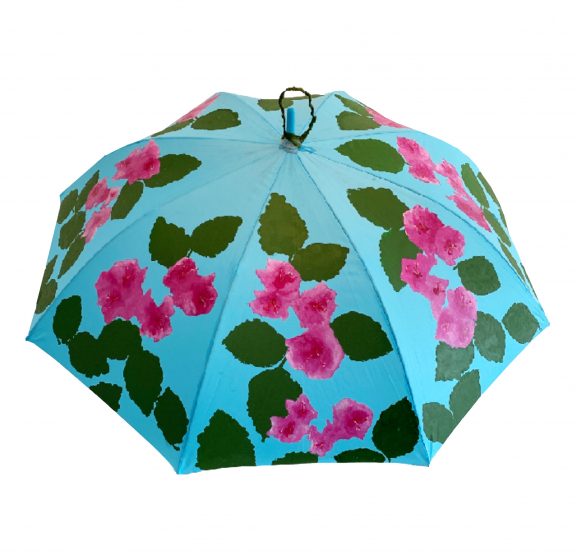
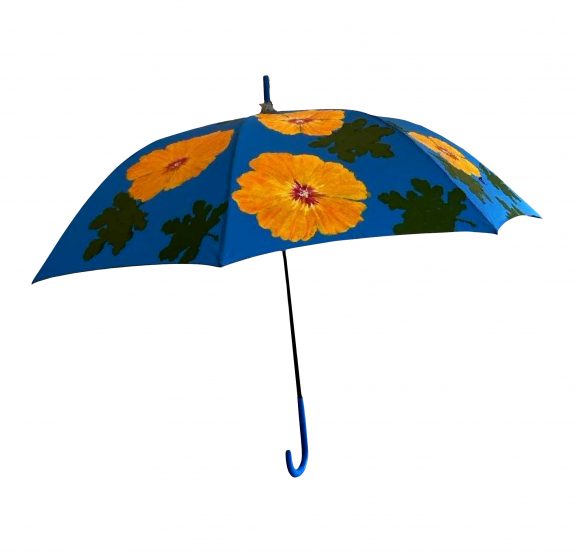
The work of Lisa very much resonated with me. I guess for me it is also a certain change of life; moving to another place. I’d like to read more from the poet Lisa used, to compliment her work.
It was said: gardens connect people, time, and latitude. And here, I could not agree more. I have only to add that sometimes we may take for granted the commonly distributed plants, as they require as much attention as the ones rarely seen.
Best of luck. And, greetings from Italy.
Baiba Pruse
Bee-keepers daughter and research on citizen science & local ecological knowledge, Venice (Amsterdam); Vrije Universiteit Amsterdam Athena Institute, the Netherlands
Video from Shade in LA
Images from the Exhibition
[foogallery id=”48987″]What does access to shade mean to you?
Visitors to the Shade in LA installation were invited to fill out a leaf and share what access to shade means to them. Here are some of the responses.
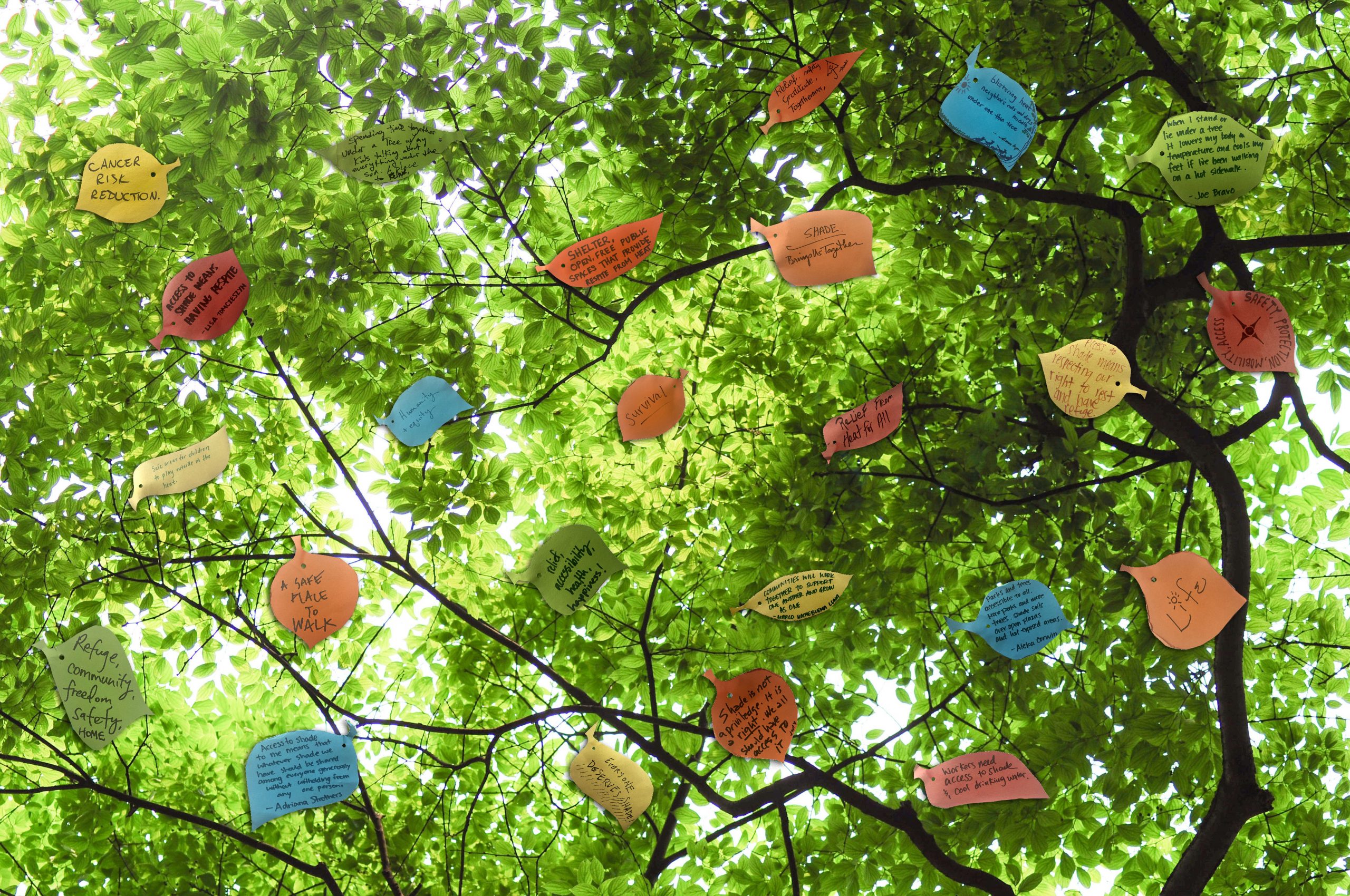


























Exhibition Credits
The original in-person exhibition was organized by Arroyo Arts Collective, and adapted as virtual exhibition by the Forum for Radical Imagination on Environmental Cultures (FRIEC) at The Nature of Cities.
VIRTUAL ADAPTATION
Forum for Radical Imagination on Environmental Cultures
at The Nature of Cities
—
production for this exhibition:
Edith and Jolly de Guzman, curators
David Maddox, TNOC director
Karen Tsugawa, web developer
artists:
Chantée Benefield – chanteeb.com | IG: @artistchantyb
Joe Bravo – joebravo.art
Mary Cheung – notjusttheordinary.wixsite.com/marycheungartist | IG: @notjusttheordinary | FB: @marycheungartist
Aleka Corwin – alekacorwin.com | IG: @alekacorwin
Pascaline Doucin-Dahlke – pascalinedoucindahlke.com
dearantler – dearantler.com | IG: @dearantler
Angela Hernandez – IG: @smokeyz.art
Diana Kohne – dianakohne.com | IG: @dianakohne
Yvette Nicole Kolodji – IG: @ynk_arts | FB: YNK ARTS | Twitter: @ynk_arts
Marco Nochebuena Luna – IG: @nochebuenaluna
Gabriel Macias – IG: @benetts_art
Brianna Mitjans – IG: @briannamitjans
Rebecca Nabarrete – sensoryoverflow.com
Isabel Olvera – IG: @M.onkeydraws
Cat Chiu Phillips – catchiuphillips.com | IG: @catchiuphillips
Adriana Strothers – IG: @adriana.s.art
Lisa Tomczeszyn – lisatomczeszynart.com | IG: @yayadesignstudio + @tomgirl56 |
FB: Lisa Tomczeszyn
exhibition photograph credits:
Edith de Guzman
Rosamaria Marquez
Genaro Molina, Los Angeles Times
For inquiries about purchasing any of the artwork, please contact the artist directly.
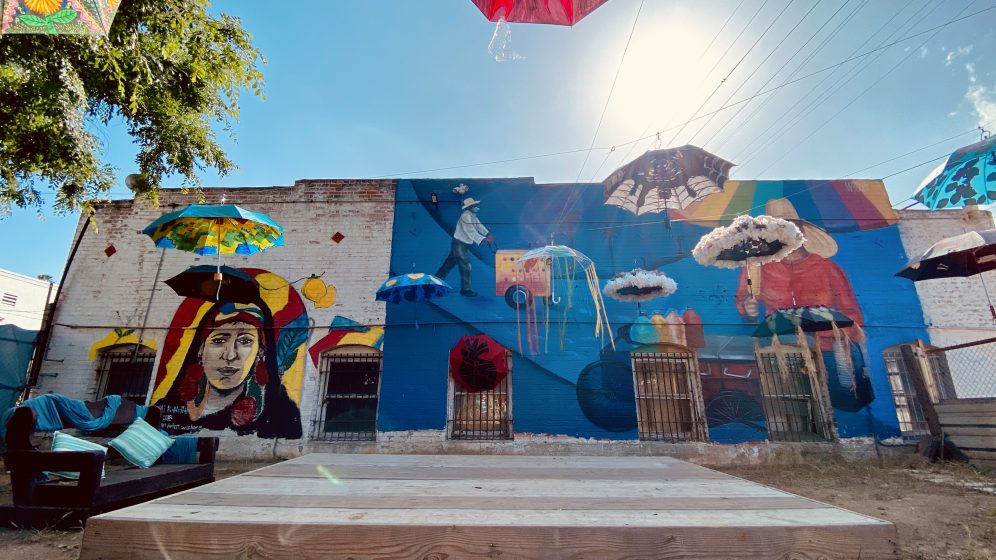
Shade in LA is made possible through the generous support of the Los Angeles Department of Cultural Affairs, the Los Angeles County Board of Supervisors through the Los Angeles County Arts Commission, and by the California Arts Council, a state agency.
Special thanks to Heather Hoggan of Arroyo Arts Collective, Kathy Gallegos of Avenue 50 Studio, Rosamaria Marquez of Rock Rose Gallery, Rachel O’Leary of City Plants, musical performances by Shoshana Ben-Horin and The Peanut Butter and Jellies, and installation assistance by Beau Matthews and Rodney Rodriguez.


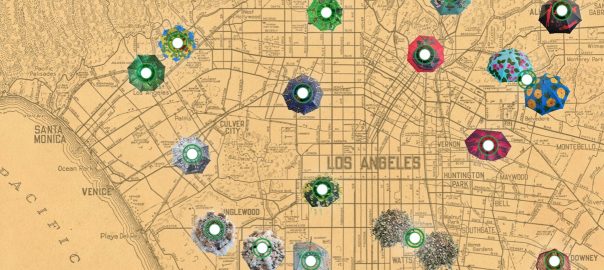



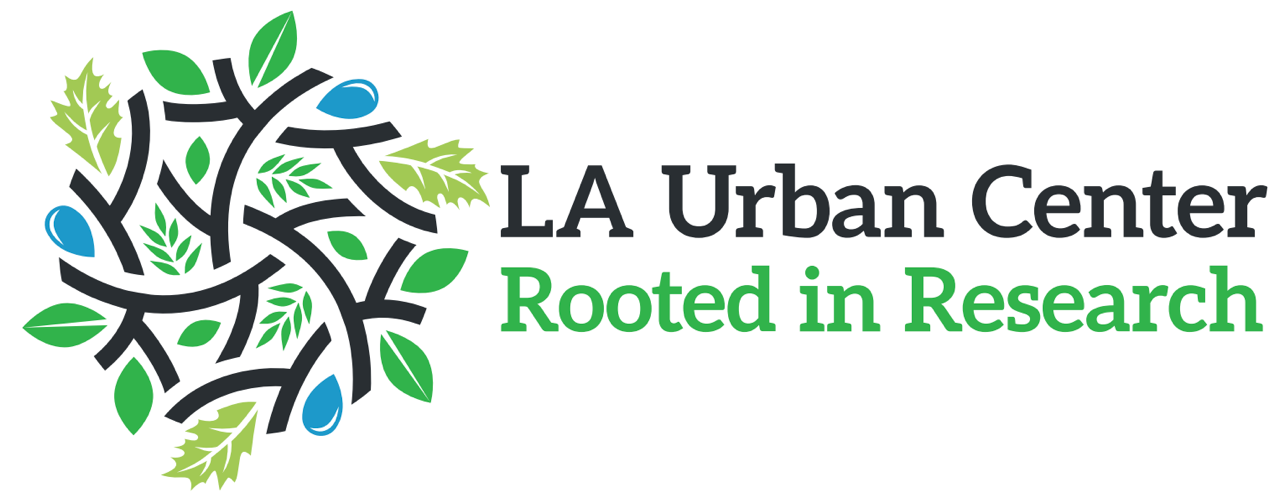
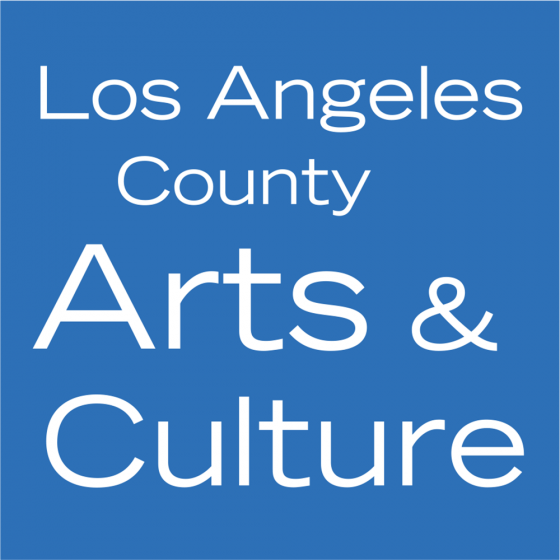

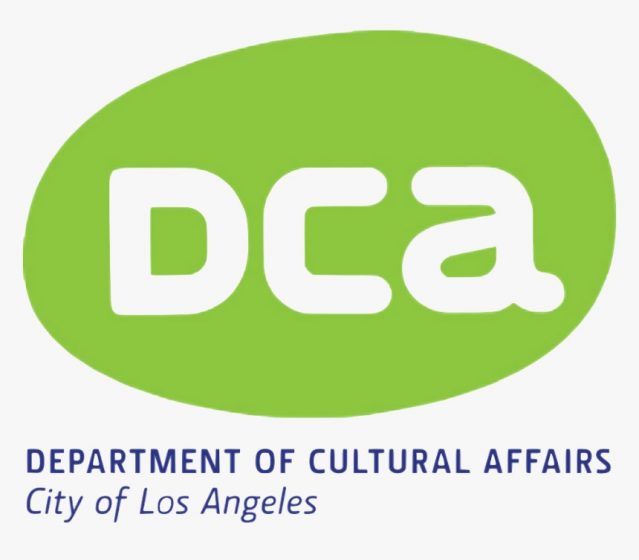
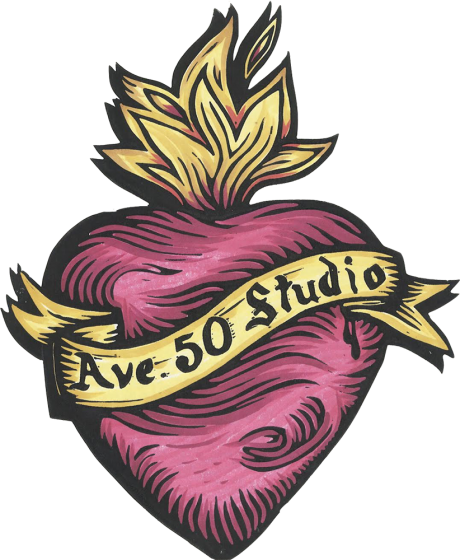
Leave a Reply